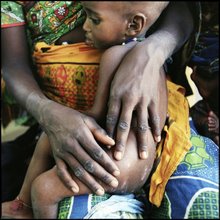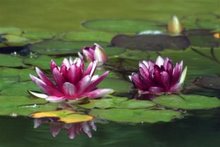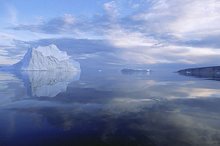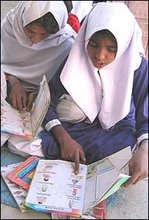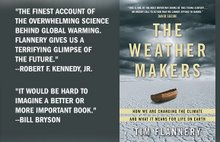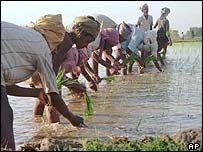PREAMBLE: Indigenous peoples from 80 nations gathered for a summit on climate change in Anchorage, Alaska, April 20-24, 2009. “Leading the Way,” organized by the Inuit Circumpolar Council (ICC), an international organization representing Arctic Inuit nations, convened some 400 participants to exchange ideas and set strategies for responding to global warming.
The Indigenous Peoples' Global Summit on Climate Change was also designed to help strengthen the communities’ participation in and articulate recommendations to the December UN conference in Copenhagen, at which a successor agreement to the Kyoto protocol will be negotiated. The Summit concluded Friday, April 24 with the signing of the Anchorage Declaration and action plan.
Says Sam Johnston of Tokyo-based United Nations University, a Summit co-sponsor: "The rich and detailed insights of Indigenous Peoples reflects and embodies a cultural and spiritual relationship with the land, ocean and wildlife. The world owes it to both the Indigenous Peoples and itself to pay greater heed to the opinions of these communities and to the wisdom of ages-old traditional knowledge."
Source: Adapted from: United Nations University, Institute for Advanced Studies. Press Release April 20, 2009. http://www.unutki.org/default.php?doc_id=145
INDIGENOUS PEOPLES AT WORLD SUMMIT SHARE CLIMATE CHANGE OBSERVATIONS, EXPERIENCE, TRAIDITIONAL COPING TECHNIQUES
With the first climate change-related relocation of an Inuit village already underway, some 400 Indigenous People and observers from 80 nations convened in Alaska for a UN-affiliated conference April 20-24 to discuss ways in which traditional knowledge can be used to both mitigate and adapt to climate change.
Hosted by the Inuit Circumpolar Council, the Indigenous Peoples' Global Summit on Climate Change was also designed to help strengthen the communities' participation in and articulate messages and recommendations to the December UN climate change conference in Copenhagen, at which a successor agreement to the Kyoto protocol will be negotiated.
The Summit took place in Anchorage, about 800 km east of the Alaskan village of Newtok, where intensifying river flow and melting permafrost are destroying homes and infrastructure, forcing 320 residents to relocate to a higher site 15 km west, at an expected financial cost in the tens of millions of dollars.
While the move will be financed in part with government funds that would have been spent maintaining the existing village and on periodic emergency evacuations, NGOs say the relocation of Newtok marks an Arctic milestone - the first official casualty among six Alaskan Inuit settlements in urgent need of relocation, including Shishmaref (pop. 560), Kivalina (pop. 377), where autumn storm waves are no longer contained by shore-fast ice, which used to form in September but in recent years has appeared only in December or even January. Dozens of similar settlements are considered threatened.
At the Summit, Indigenous Peoples from every world region shared observations and experiences of early impacts in their part of the planet, as well as traditional practices that could both ease climate change and help all humanity adapt to its anticipated consequences.
With scientific experts now predicting that the effects of climate change will be more severe and appear even faster than previously believed, Indigenous Peoples presented the Summit with new observations of changes, including:
Papua New Guinea: Indigenous People are being forced to relocate due to a combination of population growth and the inundation of coastal land due to sea level rise.
Borneo: The Dayak have documented climate variations based on observations of bird species, rising water levels, and the loss of traditional medicinal plants;
Mexico: Highland Mayan milpa farmers have a shortened rain season, unseasonal frost and unusually large daytime temperature changes, forcing them to find alternative sources of irrigation and crop variations;
Andean Region: Temperature changes in the Andean region have had a drastic impact on agriculture, health and biodiversity, evidenced by an increase in respiratory illnesses, a decrease in alpaca farming and a shortened growing season. In some areas where Indigenous People depend on Alpine flora for medicines, grazing and food, the growing season could be cut in half should the loss of glaciers continue and agriculture become dependent solely on rainfall;
Kenya: Protracted droughts are killing livestock on which the Samburu People depend for food and economic survival;
Nepal: Intense rainfall and droughts have become common, having severe crop effects.
"Indigenous Peoples have contributed the least to the global problem of climate change but will almost certainly bear the greatest brunt of its impact," says Patricia Cochran, Chair of both the Inuit Circumpolar Council and the April Summit.
"Indigenous Peoples are on the front lines of this global problem at a time when their cultures and livelihoods in traditional lands are already threatened by such trends as accelerating natural resource development stimulated by trade liberalization and globalization."
At least 5,000 distinct groups of Indigenous Peoples have been identified in more than 70 countries, with a combined global population estimated at 300-350 million, representing about 6% of humanity.
Their traditional knowledge contributes to understanding climate change - observations and interpretations by Indigenous Peoples of changing Arctic sea ice, for example, has proven important across a wide range of economic and scientific interests. Traditional knowledge of fire, meanwhile, is helping to create more effective strategies for year round forest management and reducing the risk of killer wild fires.
Interestingly, in a world first, the aborigines of Western Arnhem Land (in north-west Australia) have used traditional fire practices to reduce greenhouse gas emissions. As a result, they have sold $17 million worth of carbon credits to industry, generating significant new income for the local community.
Over millennia, Indigenous Peoples have developed a large arsenal of practices of potential benefit in the climate change context, including:
• Traditional methods of shoreline reinforcement, land stabilization and reclamation;
• Protecting watersheds with Indigenous farming techniques; and
• Fostering biodiversity and the growth of useful species through planting, transplantation, and weeding techniques, the benefits of which have often gone unappreciated outside Indigenous communities until traditional peoples are relocated or their practices restricted.
Traditional drought-related practices used to hedge against normal climate variation include:
• Sophisticated small dam systems to capture and store rainfall;
• Temporary migration;
• Planting diverse varieties of crops simultaneously; and
• Using alternative agricultural lands, food preservation techniques, hunting and gathering periods and wild food sources as required.
Among new Indigenous climate change adaptation efforts presented at the Summit:
Honduras: With increasing hurricane strikes and drastic weather changes, the Quezungal people have developed a farming method which involves planting crops under trees so the roots anchor the soil and reduce the loss of crops during natural disasters.
East Cameroon and Congo: The Baka Pygmies of South East Cameroon and the Bambendzele of Congo have developed new fishing and hunting methods to adapt to a decrease in precipitation and an increase in forest fires;
Guyana: Indigenous peoples have adopted a nomadic lifestyle, moving to more forested zones in the dry season, and are now planting manioc, their main staple, in alluvial plains where, previously, it was too moist to plant crops.
Indigenous Peoples most at risk
According to the International Union for the Conservation of Nature, the number of Indigenous Peoples most likely to be impacted to climate change requires additional research. However, those at greatest risk from expected extreme climate change-induced events such as sea level rise and crop-damaging droughts reside in:
• The Arctic,
• The Caribbean
• The Amazon
• Southern Chile and Argentina,
• Southern Africa,
• Pacific islands and other island states,
• Along the Asian coastline
• Across Australia
Beyond temperature flux, climate change is expected to alter the timing, frequency and intensity of precipitation, the direction and intensity of winds, waves, ocean currents and storm circulations, the volume of rivers, and the ranges of plants and animals.
UNU researchers say the greatest number of people will be affected by climate change through more frequent drought and spreading desertification, by rising sea levels that inundate coastal communities, through the expanded range of diseases like malaria and dengue fever, and by the disappearance of glaciers, which will stunt the usual supply of water in areas such as the Indian subcontinent, where more than 2 billion people will reside by 2050.
Source: Adapted from: Press Brief 20 April 2009: Indigenous Peoples at World Summit to Share Climate Change Experience. http://www.unutki.org/default.php?doc_id=144
FROM a Great Canadian and World Statesman
"A great gulf... has... opened between man's material advance and his social and moral progress, a gulf in which he may one day be lost if it is not closed or narrowed..."
Lester B Pearson
http://nobelprize.org/nobel_prizes/peace/laureates/1957/pearson-lecture.html
Friday, 15 May 2009
Subscribe to:
Comments (Atom)
INSPIRATIONAL WELCOME ............................... from T.S.Eliot's "Little Gidding"
If you came this way From the place you would come from... It would be the same at the end of the journey...
If you came, not knowing what you came for, It would be the same... And what you thought you came for Is only a shell, a husk of meaning... From which the purpose breaks only when it is fulfilled If at all.


